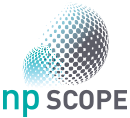Developing a new instrument
In the framework of the European H2020 project npSCOPE, an instrument that couples the extraordinarily high resolution of the recently commercialised helium-ion microscope with sensors for composition (a mass spectrometer) and 3D visualisation (transmitted ion detector) will be developed. The aim is to more fully characterise individual nanoparticles and their interaction with their biological environments (water, soil, body fluid, human cells and tissue, etc.) and to better understand the risks they might pose to human health or the environment.
The new integrated microscopy tool advanced from existing technologies and adapted specifically for the purpose of providing quick and concise analyses of nanoparticular material that can even be embedded in complex and biological matrices aims to provide a more efficient, comprehensive and accurate data in one to nanoparticle toxicology studies.

The development of the npSCOPE, will not only reinforce the leading position of Europe in the field of nanotechnology and in the field of advanced instrumentation, but also aims to:
- Allow an increased confidence in the determination of physico-chemical features, providing more reliable and consistent data for safety evaluation of nanomaterials. As well as quality control.
- Reduce costs and optimize time related to physico-chemical characterisation of nanomaterials, being a more accessible instrument than traditional approaches.
- Seek synergies in other areas such as quality control, product traceability, labelling and counterfeiting. For example, raising quality control in nanomedicine or detecting counterfeiting on cosmetic products.
A plan accross four Work Packages (WPs)
The objectives are to draw up a set of detailed specifications for the npSCOPE instrument and toxicology protocols, and to agree on conceptual design approaches and interfaces between sub-systems
The objectives are:
- To develop, build, assemble and test the subsystems required for the npSCOPE instrument (consistent with the specifications from WP1). Where necessary, the manufacture-assemble-test procedure will be repeated until the specifications are reached.
- To assemble and to perform a first functional test of the complete npSCOPE instrument.
WP3 Workflows, Software and Instrument Performance and WP4 'Benchmarking and validation' rely on the completion of the npSCOPE instrument from thisWP2.
The objectives are:
- To define a sequence of measurements on a sample that will lead to the required data (destructive techniques last!), including the special requirements for handling cryogenically prepared samples, and for finding and using fiduciary marks on the sample or sample holder.
- To create algorithms and develop software for instrument operation, data acquisition and data processing to support high throughput measurements (to gain a statistically significant description of a nanoparticle population).
- To validate the performance specifications of the npSCOPE instrument against the specifications from WP1. Testing within this work package will be done using representative and reference materials without a complex matrix.
The objectives are:
- To provide test cases relevant to real world nanotoxicology assessments including standardized protocols and methodologies for preparation, handling, exposure and analysis of nanomaterials to be used with the new instrumentation in the npSCOPE project, as a guidance for the production of high quality data.
- To validate the performance of the new instrumentation against the specifications from WP1 and benchmark this performance with respect to current state-of-the-art techniques using the aforementioned test cases.
This work prepares the ground for the standardization and harmonization process that is required in order to allow read-across and modeling of nanomaterials’ health risks. Analysis of the test cases with npSCOPE instrument will highlight strengths and weakness of the proposed technology.

